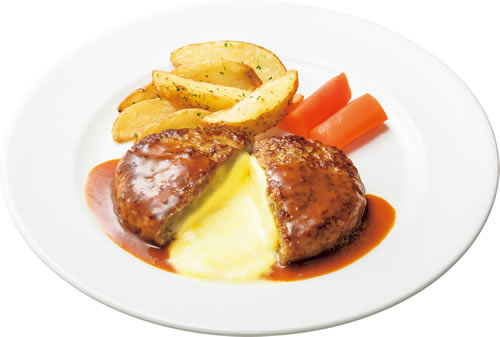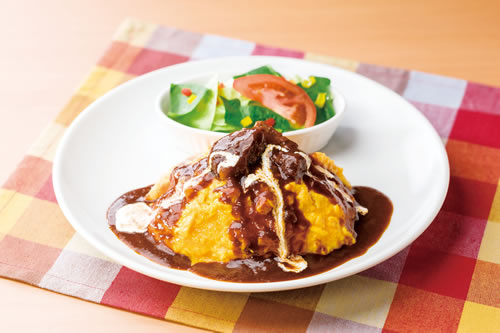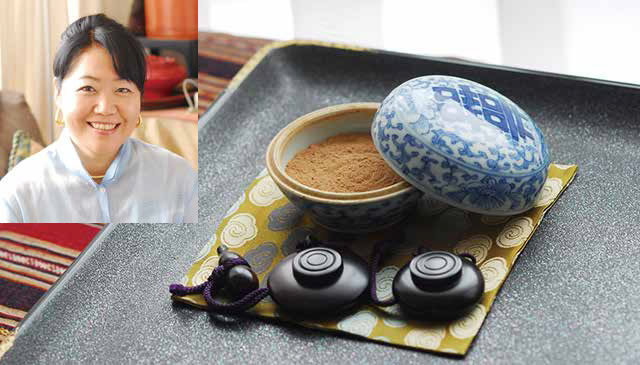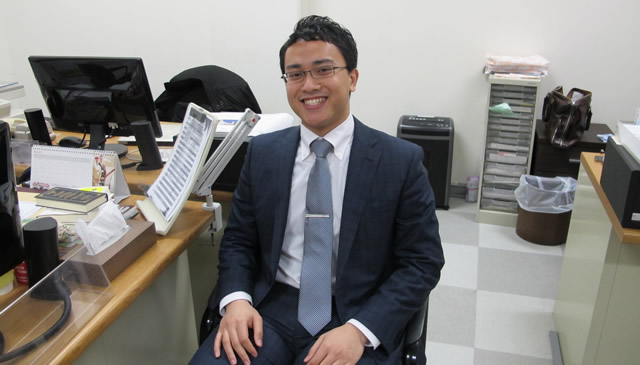[From May Issue 2015]
At Jigokudani Yaen-koen (Monkey Park) in Nagano Prefecture there are macaque monkeys known for their habit of bathing in hot springs. Visited by tourists the world over, these macaques are called “snow monkeys” in English.
The Park has some rules for visitors. Feeding the monkeys is forbidden because they can attack tourists for food. Touching the monkeys and prolonged eye contact isn’t allowed either because they will become wary. You can bring neither dogs nor cats with you. The monkeys are unafraid of humans and aren’t bothered by the tourists’ excited cries nor flash photography because visitors have always followed these rules.
The monkeys of Jigokudani used to flee as soon as they saw humans. In those days, some locals tried to exterminate them because they were running amok in fields after their habitat was lost to mountain and forest development schemes. Couldn’t there be a way to protect the farms and people’s livelihoods, while also protecting the monkeys and their living environment? Those who thought this way tried to keep the monkeys from going to the farms by creating a feeding site in Jigokudani far from any human habitation.
At that time Jigokudani was a small resort town with only one old inn and a vigorous hot spring. If its monkeys, its un-spoilt natural habitat and hot spring were turned into tourist attractions, the municipality would reap the economic benefits. This idea, which predated the emergence of ecotourism, kick started the effort to get the monkeys used to humans. With help from the inn, the locals successfully fed the monkeys and five years later in 1964, the park opened.
The monkey bath was created after baby monkeys started playing in the open-air bath of the spa inn – that had been lending its support to the park. Today, the park has open-air baths for the monkeys where many of them bathe on cold days. People visit in droves to take pictures. In this way, photos taken there have won prizes both in and outside Japan and created quite a buzz. In recent years this has led to an increase in the number of winter visitors and foreign tourists.
Though some might think the park is a winter attraction, it’s actually open throughout the year. It’s not only for tourists, but is also an institution for education and research. In the spring baby monkeys are born one after the other. Their hair is still black and you can witness the charming spectacle of suckling babies cradled in their mother’s arms. In the summer, you can see them enthusiastically playing around, independent from their mothers.
As records of the name and mother of each and every monkey covering the past 50 years have been kept by the park, university researchers visit for fieldwork from within and without Japan. The park is also used by elementary and junior high school students for outdoor classes. To get to the park, it’s a two-kilometer half-hour walk on a mountain trail from the dedicated Monkey Park parking lot. Hiking clothes will therefore be necessary and you’ll need to prepare for cold temperatures in wintertime.
Jigokudani Yaen-koen
Text: SAZAKI Ryo[2015年5月号掲載記事]長野県にある地獄谷野猿公苑には、温泉に入ることで知られるニホンザルがいます。英語では「スノーモンキー」と呼ばれ、世界中から観光客が訪れます。
野猿公苑にはルールがあります。観光客がえさをやると、サルがえさ欲しさに人を襲うようになるので禁止です。サルをさわったり目を見つめたりするのも警戒心を起こさせるのでだめです。イヌやネコを連れていってはいけません。観光客がルールを守ってきたため、サルは人間を恐れず、観光客の歓声もフラッシュを使っての撮影も気にしません。
かつて地獄谷のサルは、人間を見るとすぐ逃げていました。その頃は山林の開発が進んで住む場所を追われたサルが畑を荒らしたため、殺そうとする動きもあったからです。サルやサルが生きられる環境を保護しつつも、人間の畑や生活を守る方法はないだろうか。そう考えた人たちは人里から離れた地獄谷をえさ場とすることで、サルが畑に行かないようにしました。
地獄谷はとても熱い温泉が激しく噴き出す、古い温泉旅館が一軒だけある小さな保養地でした。サルや手つかずの自然、温泉を観光資源とすれば、地元にも経済効果があります。このようなエコツーリズムの先取りともいえる発想から、サルの群れを人に慣れさせる作業が始まりました。温泉旅館の協力もあって5年後にえづけに成功し、1964年に公苑がオープンしました。
サルの温泉は、公苑を支援してきた温泉旅館の露天風呂に、子ザルが入って遊ぶようになったことから生まれました。今では公苑内にサル専用の露天風呂があり、寒い日には多くのサルが浸かっています。たくさんの人が訪れ、撮影します。そのようにして撮られた写真が国内外で賞をとって話題になりました。そのため、近年、冬期の入苑者や外国人観光客が増えています。
冬の観光地と思う人もいるかもしれませんが、年間を通じて運営されています。観光だけでなく教育、研究のための施設でもあります。春には、子ザルが続々と誕生します。子ザルはまだ毛も黒く、母親に抱っこされておっぱいを飲む愛らしい姿を見せてくれます。夏になると母親から離れて元気に遊びまわる姿が見られます。
公苑では50年にわたってサル一匹一匹の名前や母子関係が記録されているため、国内外の大学から研究者が訪れ、フィールドワークが行われています。小中学生の野外学習にも役立てられています。公苑へ行くには、上林温泉の野猿公苑専用駐車場から山道を約2キロ、約30分歩きます。ハイキングの服装、特に冬は防寒対策が必要です。
地獄谷野猿公苑
文:砂崎良[:ja][2015年5月号掲載記事]
ジョージア駐日ジョージア特命全権大使
レヴァン・ツィンツァゼさん
「大相撲で初めて関取(十両以上)に昇進したヨーロッパ人力士はジョージア出身ですよ。現在二人のジョージア人力士が活躍していますし、柔道でわが国はオリンピックで金メダルを取っています」とレヴァン・ツィンツァゼ駐日ジョージア特命全権大使。レスリングはジョージアの伝統スポーツです。ジョージア人は強いんですと笑いながら説明します。
大使は1994年に科学者として来日し、広島大学、大阪大学、京都大学、筑波大学、日本原子力研究所でプラズマ物理学の研究を行いました。国に戻ったあと、今度は大使に任命されて2013年12月に再来日しました。「長く暮らした日本のために何かできるのは私にとって喜びであり、名誉です。日本もジョージアも共に素晴らしい国なので、両国の関係を強化するために働けるのは嬉しいですね」。
日本に来たときの印象は、清潔でよく整った国でした。「日本人は義務と義理を大事にしますね。もちろんどの国にも自立している人はいますが、それらに価値を置く日本人はとても多いと思います。ジョージアにもそういう人が増えてほしいですね」と言います。
日本での生活にはすぐ慣れました。「もちろん、どんなヨーロッパ人も日本に初めて来たら、日本人が外国へ行ったときのように、多少の苦労はあるでしょう。でも対処できないほどの困難を感じたことはありません」と大使。「来日したばかりの頃はテレビ番組に驚きました。変わっていると思いました」。

「余暇は、できるだけ息子と共に過ごすようにしています。いっしょに散歩したり公園へ行ったり、自転車に乗ったりしています」と大使は言います。「それ以外には、読書が趣味ですね。いろいろな国の文学を、原語で読めれば原語で、そうでなければ翻訳で読みます。日本の文学も読みましたよ。文化や歴史が理解できて面白かったです」。
ジョージアは黒海の東岸にあり、面積は日本の5分の1ほどです。約180万年前の人類の骨や、8千年前のワインづくりの施設が発見されるなど、ヨーロッパ文明が開けた地と見られています。ジョージアはワインの発祥地でもあります。伝統的な製法で数千年続けてきましたが、今日でもほとんど変わりません。
「日本に来て甲州ワインを初めて口にしたとき、ジョージアのワインに似ていると思いました。山梨県に行って、その印象はいっそう強くなりました」と大使は言います。その後ある研究グループのDNA解析で、甲州のブドウのルーツがジョージアにあると判明しました。ジョージアは東西の文明の交差点です。甲州ブドウもシルクロードを通って日本へ伝わったのでしょう。
ワインの風味以外にも、日本とジョージアには共通点があります。「どちらも古代からある国で古い文化、独自の伝統を今日まで維持してきました」と大使は話します。日本人のホスピタリティーは有名ですが、ジョージアもこの点は日本と競争できます。ジョージアのホスピタリティーは伝統的で、お客は神からつかわされた存在と考えます。お客が来るのは、ホストがお客にふさわしい人だという意味なのです。

ジョージア人は日本を長い歴史のある偉大な国だと思っていると大使は言います。そして、すぐれた文学や映画を生み出しており、古い伝統を維持していながら同時に超近代国家だと言います。「残念ながら、全ての日本人がジョージアを知っている訳ではありません。日本からジョージアへ来る観光客も増えてはいますが、もっと2倍3倍にも増えてほしいですね。日本人は一度訪れたら、絶対ジョージアが好きになりますよ」。
ジョージアの魅力はバラエティーに富む自然だと大使は言います。ジョージアは車で7時間ほど走れば横断や縦断ができる広さですが、そのドライブの最中に周囲の気候がどんどん変わっていきます。国内に12もの気候区があるのです。「黒海沿岸で楽しんだ後、車を飛ばして海抜2千メートル級の山へ行けますよ。海水浴とスキーを一日で楽しめるなんて、他にこんな国がありますか」とほほえみます。
「ジョージアのミネラルウォーターもお勧めです。2,400もの湧き水があって、ヘルシーな水として人気です。また、ジョージアの土はとても肥沃なので、果物も野菜もみなとてもおいしいです。ハチャプリというチーズパンに似た食べ物は特にいいですよ。ジョージアの料理は東西のさまざまな文明の影響を長年にわたって受けて生まれたものです。多様な気候のせいもあって地方にはそれぞれの特色があります」。
「歴史的な建造物も見ごたえがあります」と大使。「この地では非常に古くから製鉄や農業が行われていました。ジョージア語は現存する言語の中で最も古い言語の一つで独自のアルファベットを持っています。ジョージアはキリスト教を国教として受け入れた最古の国の一つでもあり、周囲の大国から絶えず干渉されながらも独自の文化を守り抜いてきました」。

「観光にお勧めなのは、世界遺産にも登録されている5世紀の歴史文化記念碑ですね。12世紀の岩窟住居もいいですよ。リラックスしたい人は美しい景色を見てのんびりと、活動的な人は登山や狩りをして、歴史好きな人は遺跡へ、とさまざまに楽しめます」。
旧ソ連で活躍し、日本にも知られている人の中には、実はジョージア人が大勢いました。優れた科学者や芸術家、俳優、バレエダンサー、シンガーたちです。ジョージア人はとても才能がありポジティブなのです。
日本政府は「グルジア」の国名表記を2015年4月から「ジョージア」にしました。
ジョージア大使館
文:砂崎良[:en][From May Issue 2015]“The first European sumo wrestler to be promoted to the juuryou (junior grade) division was Georgian. Today we have two successful Georgian sumo wrestlers and we have won gold medals in Olympic judo,” says Dr. Levan TSINTSADZE, Ambassador Extraordinary and Plenipotentiary of Georgia to Japan. He laughs when he explains that wrestling is a traditional sport in Georgia and that Georgians are strong by nature.
The Ambassador first came to Japan in 1994 as a scientist, and conducted research into plasma physics at the Universities of Hiroshima, Osaka, Kyoto, Tsukuba, and also at the Japan Atomic Energy Research Institute. After he returned to Georgia, he went to Japan again in December, 2013, this time as an ambassador. “I’ve spent so much time in Japan, so it’s a pleasure and an honor to be able to do something for the country. Both Japan and Georgia are such wonderful countries that I’m glad I can work to strengthen our relationship.”
His first impression of Japan was that it was a clean and well-organized country. “Japanese people attach importance to duty and obligation. You find self-organized people in any country of course, but I think the number of Japanese with those values is very high. I’d like to see more people like that in Georgia,” he says.
He quickly got used to life in Japan. “Naturally, any European will have some difficulties in Japan if it’s their first time; just like when Japanese go abroad. I haven’t had any difficulties that I couldn’t overcome,” says the Ambassador. “In the beginning I had a startling impression of the TV programs. I found them a bit strange.”“My spare time is devoted as much as possible to my son. We take walks in parks, we also used to ride bicycles together,” says the Ambassador. “Other than that, my pastime is reading. I read literary works from different countries in the original language if I can, or in translation if I can’t. I’ve read Japanese literature, too. I enjoyed it and it helped my understanding of Japan’s culture and history.”
Georgia is on the eastern coast of the Black Sea and is about a fifth of the size of Japan. With the discovery of 1.8 million-year-old human bones and evidence of wine-making dating back 8,000 years, Georgia is regarded as the birthplace of the first European civilization. Georgia is the birthplace of wine as well. The wine making tradition has been practiced in Georgia for thousands of years and has been preserved until nowadays almost unchanged.
“After arriving in Japan, I tasted Koshu Wine for the first time and thought it tasted like Georgian wine. That impression was reinforced when I went to Yamanashi Prefecture,” says the Ambassador. A group of researchers has since determined by DNA analysis that Koshu grapes have their origins in Georgia. Georgia is at the crossroads of Western and Eastern civilizations. Koshu grapes must have reached Japan by the Silk Road.Japan and Georgia have other things in common besides the flavor of their wines. “Both countries have existed since ancient times and we’ve preserved our culture and unique traditions to this day,” says the Ambassador. Japanese hospitality is well-known, but Georgians can compete with Japanese in that area. Georgian hospitality is legendary, guests are considered to be a godsend in Georgia. If someone comes to your place, it means the host is a person worthy of that guest.
The Ambassador says that Georgians consider Japan to be a great country with a long history. He says that it has produced excellent literary works and movies and is a super modern nation that also preserves its old traditions. “Unfortunately, not everyone in Japan knows about Georgia. The number of Japanese tourists to Georgia is increasing, but I’d like this to double or triple. I bet Japanese people would love Georgia once they visited it.”
The Ambassador says that the charm of Georgia is in its rich variety of natural sites. By car, you can cross Georgia east to west, or north to south in about seven hours. The climate keeps changing as you travel. The country has as many as 12 different climatic zones. “After having a good time on the coast of the Black Sea, you can drive to mountains 2,000 meters above sea level. Is there any other country where you can enjoy bathing in the sea and skiing on the same day?” he says, smiling.
“I’d recommend Georgia’s mineral water. The country has as many as 2,400 springs and they are popular for their healthy water. The soil of Georgia is so fertile that our fruits and vegetables are all delicious. Khachapuri, a dish that resembles a cheese bread, is especially good. Georgian cuisine developed under the influence of various Eastern and Western civilizations over the course of centuries. Each region has its specialty and that’s also due to the diversity of climate.”“Our historical buildings are gorgeous,” says the Ambassador. “Iron making and agriculture have been practiced since ancient times in that part of the world. Georgian is one of the oldest living languages in the world and has its own unique alphabet. Georgia was one of the first countries to accept Christianity as its national religion. We’ve preserved our unique culture despite constant interference from surrounding powers.”
“For sightseeing, I’d recommend historical and cultural monuments, some of them from the fifth century, that are listed as World Heritage sites. The cave dwellings carved into rocks from the 12th century are also impressive. Those who want to relax can see beautiful sights and unwind. Active people can climb mountains or hunt. History buffs can go to historic sites. There are so many ways to enjoy yourself.”
There were quite a few important Georgians well-known in Japan during the days of the former Soviet Union. They were fir-rate scientists, artists, actors, ballet dancers, and singers. Georgians are very talented and positive people.
The Japanese Government changed the transliteration of the name for Georgia from “Gurujia” to “Jo-gia” in April 2015.
Georgia Embassy
Text: SAZAKI Ryo[:][From May Issue 2015]
In Nanto City, Toyama Prefecture there are two villages with unique so called “gasshou-zukuri” style steeply sloping thatched roofs. This year marks the 20th anniversary since they were registered as a World Heritage Site. While most of the houses were built around 100 to 200 years ago, some of them have a history of around 400 years. Residents still live in them and at houses where accommodation and meals are provided, guests are served edible wild plants and iwana mountain trout by the hearth. The site is also a centre of production for washi Japanese paper and visitors can make round fans and postcards by taking part in the Japanese paper-making experience. From around mid-May every year, Ainokura Village is illuminated to create a magical Japanese countryside scene that will delight visitors.
Access: At JR Shin-Takaoka Station, get on the “World Heritage”bus, get off at “Ainokuraguchi”and walk about five minutes to Ainokura Village, or get off at “Suganuma” and walk about three minutes to Suganuma Village.
Gokayama Tourist Information Center
Opening hours: 9:00 a.m. – 5:00 p.m.
To park in the villages you must pay a fee that will be used for the conservation of these properties: 500 yen for standard or light vehicles, 100 yen for two-wheeled vehicles.
http://www.gokayama-info.jp/
Text: KAWARATANI Tokiko[2015年5月号掲載記事]富山県南砺市にある2つの集落で、合掌造りと呼ばれるかやぶき屋根が特徴。今年世界文化遺産登録20周年を迎える。100~200年前のものが多いが、約400年前に建てられたものもある。住民が今も生活しており、民宿ではいろりのそばで山菜やイワナが食べられる。和紙の産地としても知られ、和紙すき体験ではうちわやはがきを作ることができる。毎年5月中頃には相倉集落はライトアップされ、幻想的な日本の原風景が楽しめる。
交通:JR新高岡駅から世界遺産バスで「相倉口」下車、相倉集落まで徒歩約5分。または「菅沼」下車、菅沼集落まで徒歩約3分。
500 yen for standard or light vehicles, 100 yen for two-wheeled vehicles.
五箇山総合案内所
営業時間:午前9時~午後5時
相倉、菅沼集落の駐車場を利用するには、集落保存協力金として駐車代が必要。普通車、軽自動車500円、二輪車100円。
http://www.gokayama-info.jp/
文:瓦谷登貴子[From May Issue 2015]
“Gusto” is Japan’s only family restaurant chain to have a branch in every single prefecture. The number of these stores exceeds 1,350. Here you can enjoy a wide variety of dishes for a reasonable price. The chain started as a self-service drink bar. Gusto is a community restaurant with close regional ties. There is also a sister chain of restaurants called “Steak Gusto” that focuses on steaks and hamburgers.
[No.1] Cheese IN Hamburger 499 yen
One of Gusto’s signature dishes. Four kinds of cheese, including camembert and mozzarella, are used. When you cut into the juicy hamburger with a knife, cheese oozes out.

[No.2] Generous Helping of French Fries 299 yen
These crispy potato fries have been enjoyed by customers since the company first opened for business. Recommended for groups to share.

[No.3] Omelet and Rice with Beef Stew Sauce Plate 699 yen
Fluffy omelet on a bed of rice covered with a thick beef stew and red wine sauce. The beef is cooked until it is very soft. Comes with a side salad.

※ Availability and prices vary depending on the restaurant.[2015年5月号掲載記事]「ガスト」は日本でただ一つ、全都道府県に店舗があるファミリーレストラン。店舗数は1,350店以上。バラエティー豊かなメニューをリーズナブルな価格で楽しめる。セルフサービスのドリンクバーを最初に始めた。地域に密着したコミュニティーレストラン。ステーキやハンバーグを中心とした「ステーキガスト」もある。
【No.1】チーズINハンバーグ 499円
ガストの看板メニュー。カマンベール、モッツァレラなど4種のチーズを使っている。ジューシーなハンバーグにナイフを入れると中からチーズがあふれ出す。
【No.2】ポテトフライ(山盛り) 299円
創業当初からの人気商品で、ほくほくとした食感が楽しめるポテトフライ。大勢でシェアしたいときにおすすめ。
【No.3】オムライスビーフシチューソースプレート 699円
赤ワイン入りの濃厚なビーフシチューソースがかかった、ふわふわ卵のオムライス。牛肉はやわらかくとろとろに仕上げている。サラダ付き。
※店舗により販売有無・価格は異なります。
[From May Issue 2015]

Incense Specialist
WATANABE Eriyo
Kodo “the way of incense” is a traditional art in Japan. Rather than saying “smell” the aromatic wood, we say “listen” to it. Listening to incense means appreciating its fragrance with keen attention. “Japan has four seasons. It’s blessed with the scents of different trees and flowers each season and a moderate level of humidity,” says incense specialist WATANABE Eriyo.
“The climate, too, from Hokkaido to Okinawa, is diverse; the country has 3,000 meters high mountains and a rich ecosystem. This environment has nurtured the delicate sensibilities of the Japanese people, especially our sense of smell and taste. I’m interested not only in Japanese aromas, but also in aromas from other countries, from history and how these relate to each other.”
Watanabe opened her “Setagaya Incense Salon” in Tokyo and from this base, she organizes workshops in which people make nerikoh (blended incense balls made by mixing together the raw materials and honey) based on a 1,000-year-old Japanese recipe and learn, through incense, about Japan’s classical literary works and traditional culture. All kinds of people participate, from foreigners who want to “experience something typically Japanese” to regulars who “look forward to listening to lovely fragrances.”
Watanabe organizes gatherings at which participants simply listen to incense. Many come just for one day. “When a workaholic listens to incense, their expression softens as if a mask has slipped off,” says Watanabe.
“It’s of course wonderful that kodo is such a rich subject, but it can also be a mental challenge because differentiating scents by ‘listening’ to them and comparing them is competitive. I want people to enjoy the calming and relaxing effects of incense, so they don’t compete with each other, they simply fully enjoy the fragrances. Since ancient times, incense has always been referred to as food for the soul. If you concentrate only on the fragrance, you lose your ego, become one with the whole universe and experience a state of bliss,” says Watanabe.
The reputation of Setagaya Incense Salon is spreading by word of mouth. The salon has been mentioned on an Australian travel website as one of the “Top Ten Things to Do Only in Tokyo” and on a German travel website as “a relaxing place.” “The enjoyment of scent has always been a cultural practice that has spanned the globe,” says Watanabe. Burning incense is a sacred act in Christianity, Islam, and in Buddhism. Since antiquity, there has been an international trade in the raw materials used to make incense.”
“As a student of art history in London, I rediscovered Japan when I learned that ‘Japan’ also meant lacquer ware. I later studied expressive arts therapy in Boston and while working in that area, I realized that incense had the same effect as expressive arts therapy. My biggest personal asset is the cross-cultural experience acquired on trips to 48 countries and during the time I lived abroad for ten years.”
Watanabe says enthusiastically, “When I burn incense that I made with a wish or a prayer, it feels as though that wish or prayer reaches heaven. I’d like to create new kinds of incense equipment and market them to the world.”
Incense Research Institute
Text: SAZAKI Ryo/文:砂崎良[2015年5月号掲載記事]香研究家
渡辺えり代さん
日本には香道という伝統文化があります。香道では香木の香りは「かぐ」といわず、「聞く」といいます。聞香とは、心を研ぎ澄まして耳を傾けるように香りを鑑賞するという意味です。「日本は四季があります。それぞれの季節の樹木や花の香りに恵まれ、適度な湿気もあります」と香研究家の渡辺えり代さんは話します。
「また、北海道から沖縄まで気候が多様で、3千メートル級の山々もあり、生態系が豊かです。この環境が日本人の繊細な感覚、とくに嗅覚と味覚を育んだのです。私は、日本のお香に限らず、世界の香文化と歴史、そしてつながりに興味をもっています」。
渡辺さんは東京で「世田谷香サロン」を開いていて、そこを拠点に、日本に千年前から伝わるレシピに基づいて練香(香原料を蜜で練り合わせたお香)を作ったり、お香を通じて日本の古典文学や伝統文化を学ぶワークショップを開いています。参加者は、「日本らしいことを体験してみたい」という外国人から、「いい香りを聞くのが楽しみ」と通う人までとさまざまです。
渡辺さんが行っているのは、シンプルに香りを聞く集まりで、一日だけ受講する人もたくさんいます。「ばりばり働いている方がお香を聞くと、仮面が落ちたかのようにやわらかい表情になるんですよ」と渡辺さんは言います。
「伝統的な香道はもちろん奥が深くてすばらしいですが、香りを聞き比べてそのお香の名前を当てるという競技形式なので、頭を使います。私はお香の鎮静作用やリラックス効果を味わっていただきたいので競技はせず、いい香りを堪能していただくやり方をとっています。お香は昔から魂の食べものといわれていて、無心になって香りに集中すると、自分という枠の意識が消えて、宇宙全体と一つにとけ合い、至福を感じます」と渡辺さん。
世田谷香サロンは口コミで広まっています。オーストラリアの旅行サイトで「東京だけでできることトップテン」の一つとして取りあげられたり、ドイツの旅行サイトでも「リラックスできる場所」と書かれたりしました。「お香を楽しむのは、そもそもとても国際的な文化なのです」と渡辺さん。キリスト教でもイスラム教でも仏教でもお香をたくというのは神聖な行為です。香原料の交易は古代から国際的に行われてきました」。
「ロンドンで美術史を学んでいたとき、JAPANが漆器を意味すると知って日本を再発見しました。その後ボストンで芸術療法を修めてその仕事をし、芸術療法によって得られる効果がお香にもあると気がついたのです。48ヵ国への旅と10年間の海外生活から得た異文化体験は私の一番の財産です」。
渡辺さんは「祈りや願いをこめて作った練香をたくと、その思いが天に届くような気がします。新しいスタイルの香道具を開発して、世界に発信したいです」と意気込みます。
香研究会IRI
文:砂崎良[From May Issue 2015]
Calbee
In Japan, fried carbohydrate snacks of corn, potatoes, or beans, are called “snack gashi.” CALBEE, Inc. products account for a 50% share of this market. The word Calbee is neither Japanese nor English. It conveys the sentiments of the company’s founder who was thinking of the nation’s good health when he coined the word.
Founded in Hiroshima Prefecture in 1949, the company was formerly known as Matsuo Food Industries. MATSUO Takashi, then president, was concerned about malnutrition among post-war Japanese people and aimed to create products that would improve the health of consumers. The company name was changed in 1955 to Calbee Foods and Confectionery Co., Ltd.; a name that combines calcium, “cal,” and vitamin B1, “bee.”
In that same year, the company succeeded in making arare (roasted mochi pieces) from wheat rather than rice – the main ingredient up until then – and marketed it as “Kappa Arare.” In 1964, “Kappa Ebisen,” a snack made from mixing ground raw shrimp into wheat dough, was developed. It became a big hit and the jingle “I can’t stop, I won’t stop, Calbee, Kappa Ebisen” made the Calbee name popular throughout the nation.
The year 1972 saw the launch of the potato based snack, “Sapporo Potato.” The company’s name was shortened to CALBEE, Inc. when its head office moved from Hiroshima to Tokyo in 1973. In 1975, “Potato Chips” was launched, a snack which later became one of the company’s core products. In 1985, the material used in the packaging of all products was switched from vinyl to aluminum film. This prevented any loss of flavor caused by oxidation.
Calbee takes great care in its control of raw ingredients. For example, shrimps – one of the ingredients in Kappa Ebisen – are carefully selected, flash-frozen while fresh to a temperature lower than -30 °C and transported to the factory. In the factory, the entire shrimp, including shell, is ground up and used. Red particles on the exterior of Kappa Ebisen are proof that the whole of the shrimp is used.
Approximately 330 thousand tons of potatoes are procured yearly to make potato chips and other products. From breeding potato varieties to cultivation, to storage, to transportation, to sales, an agreement has been made with other manufacturers to work in cooperation with each other to ensure the entire process goes smoothly. Currently more than 1,000 producers in the Hokkaido area alone have entered into this contract. The so-called field men of Calbee Potato, Inc. (an affiliated company in charge of potato procurement, storage, etc.) support the producers with surveys, advice and an exchange of information concerning cultivation.
Calbee products are consumed in ten other countries. For example, “Harvest Snaps” made from beans are popular in the US, Canada, and the UK. In Singapore, “Hot & Spicy” potato chips are a hit and in Thailand, “Kappa Ebisen Original” – developed locally for the Thai palate – is selling well.
The total number of products produced by Calbee in Japan in the financial year of 2013 was 1.8 billion. The company organizes “Calbee Snack Schools” to teach children how to have a healthy enjoyable diet. In 2013 62,251 children in 787 schools across the nation attended the course. This project not only increases the number of Calbee fans, but is also the company’s way of contributing to regional development.
CALBEE, Inc.
Text: ITO Koichi[2015年5月号掲載記事]カルビー
日本では、トウモロコシやイモ、豆などの炭水化物を使って揚げた菓子類を「スナック菓子」と呼んでいます。この分野で国内の半分を超えるシェアを占めているのがカルビー株式会社の商品です。カルビーは日本語でも英語でもありません。国民の健康を願う創業者の気持ちが込められた造語です。
同社の前身は1949年に広島県で設立された松尾糧食工業株式会社です。当時の社長だった松尾孝さんは戦後の日本人が栄養不足に陥っていることに胸を痛め、健康に役立つ商品づくりを目指しました。1955年、大事な栄養素であるカルシウムの「カル」とビタミンB1の「ビー」を組み合わせたカルビー製菓株式会社に社名を改めました。
同じ年に、本来は米でつくるあられを小麦でつくることに成功し、「かっぱあられ」として売り出しました。1964年には生えびを小麦生地に練りこんだ「かっぱえびせん」を開発。これは「やめられない、とまらない、カルビー、かっぱえびせん」というCMソングと共に大ヒットし、カルビーの名を全国に広めました。
1972年にはじゃがいもを原料にした「サッポロポテト」を発売。1973年に本社を広島から東京へ移したのを機に現在の社名に変更しました。1975年には同社の代表商品となる「ポテトチップス」を売り出しました。1985年からは全製品の袋をビニール製からアルミ蒸着フィルムに変えました。これによって酸化で風味が落ちることがなくなりました。
カルビーは原料の管理にとても気をつかっています。例えば、かっぱえびせんの原料となる小えびは厳選され、新鮮なうちにマイナス30度以下に急速冷凍され、工場に運ばれます。工場では小えびを殻ごとミンチにして頭からしっぽまで丸ごと使います。かっぱえびせんの表面に赤いつぶつぶがあるのは、小えびをすべて使っている証拠です。
ポテトチップスなどに使われるじゃがいもの調達量は年間約33万トン。契約生産者と協力し、品種の開発から栽培、貯蔵、輸送、販売までを一貫して管理する仕組みを整えています。現在は北海道だけで1,000人以上の生産者と契約しています。フィールドマンと呼ばれるカルビーポテト株式会社(じゃがいもの調達、貯蔵などを担うグループ会社)のスタッフが栽培に関する調査や助言、情報交換で生産者を支援します。
カルビーの製品は海外10ヵ国でも食べられています。例えば、アメリカ、カナダ、イギリスでは、豆を原料に使った「ハーベストスナップス」が人気です。シンガポールではポテトチップスの「ホット&スパイシー」が、タイではタイ人の好みにあわせて現地で開発した「かっぱえびせんオリジナル」が売れています。
2013年度のすべての商品の国内生産量は約18億袋。同社は子どもたちに健康的で楽しい食生活の仕方を伝える「カルビースナックスクール」を開催。同年度は全国787校の62,251人が受講しました。この企画はカルビーファンを増やすだけでなく、地域貢献策としても役立てられています。
カルビー株式会社
文:伊藤公一[From May Issue 2015]

Furat BANTAN
“It’s gotten so that when I’m with non-Japanese friends in a restaurant, waiters only address me. Of course, I can speak Japanese and added to that, since I am of Indonesian descent, I appear to be Japanese, however I am a Saudi Arabian born and raised in Mecca,” says Furat BANTAN in a droll manner with perfect pronunciation. “I am Bantan, just like junbi bantan (completely ready,)” he jokes.
Japanese anime and games are extremely popular with young people in Saudi Arabia. Bantan also became interested in Japan because of this. “I watched Japanese anime and played Japanese games that were not translated into Arabic with the help of English subtitles. Thanks to this, I became accustomed to the Japanese language and, since I often checked words in the English dictionary, I memorized English words as well,” he laughs.
After graduating from high school Bantan won a scholarship from the Saudi Arabian government to study aboard and elected to go to Japan. “In Saudi Arabia, Japanese cars, air-conditioners, TVs and so forth are highly prized. I also wanted to learn about such advanced technology,” he says.
When Bantan came to Japan he attended a Japanese language school in Osaka. “Teachers admired me and said ‘Bantan, your Japanese is very good,’ but my listening, pronunciation, and keigo (formal language) skills were all down to watching anime,” he says modestly. One year later, he entered the Tokyo Institute of Technology – one of Japan’s most prestigious universities.
What awaited him at university were classes in which scientific and technical terms were frequently used. “I didn’t even understand which textbook I had to open. I asked the Japanese student sitting next to me ‘which one is it?’ and received an astonished look,” says Bantan. Moreover, the classes and textbooks were aimed at students who’d studied the curriculum of Japanese high schools. “Classes progressed as if I would naturally know things I had not learned at high school in Saudi Arabia.”
Bantan could not keep up with the classes at all and he had to repeat his first year. “It was so difficult that I wanted to die. There was an exchange student from my own country in my dormitory, so we survived by cheering each other up. After all, kanji is difficult. Arabic letters are phonetic symbols, so I had a very hard time with kanji which have numerous pronunciations,” he says.
Bantan bought textbooks written in English and studied by comparing the Japanese textbooks to them. “I taught myself from the most basic level with titles like ‘anyone can understand’ and ‘for Dummies’ (for people who do not know the subject). Because English was not my mother tongue, it was difficult to understand the contents. But I came to understand the technical terminology as I checked the equivalent term in English.” After about a year and a half of entering university he came to understand what was being taught in class. He passed the N1 grade of the Japanese proficiency test when he was in his senior year.
He also experienced the Japanese system of job hunting. “Because Japanese companies demand that I act the same way as Japanese natives, I wore a suit and carried a bag just like them,” he says humorously. When (the then) Crown Prince Salman visited Japan from Saudi Arabia, Bantan acted as an interpreter. Currently, he works at a Saudi Arabian government office located in Tokyo. “I want to encourage interaction between Saudi Arabia and Japan. In addition, it’s my dream to someday start a business. I want to dedicate my entire life to creating the Bantan Group that will establish and run schools teaching Arabic, regular schools, mosques, and more.”
Text: SAZAKI Ryo[2015年5月号掲載記事]フラート・バンタンさん
「外国人の友人たちとレストランにいると、店員が僕にだけ話しかけてくるようになります。確かに僕は日本語が話せますし、インドネシアの血を引いているので日本人にも見えるようですが、メッカで生まれ育ったサウジアラビア人ですよ」と、フラート・バンタンさんは完璧な発音で、ひょうきんに話します。「準備万端のバンタンです」とジョークも飛ばします。
サウジアラビアでは日本のアニメやゲームが青少年に大人気です。バンタンさんもそれで日本に興味を持つようになりました。「アラビア語には訳されていない日本のアニメやゲームを、英語字幕を頼りに見たりプレーしたりしていました。おかげで日本語に慣れましたし、英語辞書をよく引いたので英単語も覚えました」と笑います。
バンタンさんは高校卒業後、サウジアラビア政府の奨学金で留学できることになり、日本を選びました。「サウジアラビアでは、日本の車やエアコン、テレビ等がとても評価されています。そういう高い技術を学びたいという気持ちもありました」と言います。
来日したバンタンさんは大阪で日本語学校に通いました。「先生たちは、バンタン君はとても日本語が上手ですねと感心していましたが、聞き取りや発音、敬語ができたのはアニメで慣れていたからです」と謙遜します。1年後、難関大学の一つ、東京工業大学に入学しました。
大学で待ち受けていたのは、理系の専門用語がひんぱんに出てくる授業でした。「開くべき教科書もわからず、となりの日本人に『どの本ですか』と聞いて、あきれられました」とバンタンさん。それに授業や教科書は、日本の高校のカリキュラムで学んできた学生向けにできていました。「サウジアラビアの高校では教わらなかったことも、当然知っているものとして授業が進んでいきました」。
バンタンさんは授業にまったくついていけず、1年目は留年してしまいました。「死にたいと思うくらいつらかったですね。寮に同国の留学生がいたので、なぐさめ合って乗り切りました。やはり漢字は難しいです。アラビア語の文字は表音文字なので、読み方が何通りもある漢字にはとても苦労しました」と言います。
バンタンさんは英語で書かれた教科書を買って、日本語のものと読み比べながら勉強しました。「タイトルに『だれでもわかる』とか『for Dummies』(わからない人のための)とか書いてある、いちばん低いレベルから独学しました。英語も母語ではありませんから、内容を理解するのが大変でした。でも専門用語は英語と突き合わせているうちにわかるようになりました」。入学して1年半ほど経った頃から授業がわかるようになりました。4年生のときにはN1に合格しました。
日本の就職活動も経験しました。「日本の企業は日本人と同じ行動をすることを求めるので、リクルートスーツを着てカバンを持って、ですね」とおどけて言います。サウジアラビアからサルマン皇太子(当時)が来日したときには通訳を務めました。今は東京にあるサウジアラビアの政府機関で働いています。「サウジアラビアと日本の架け橋になりたい。そしていつかは起業するのが夢です。アラビア語を教える学校や、普通の学校、モスクなどを設立・運営するバンタン・グループを一生かけてつくりたいです」。
文:砂崎良[From May Issue 2015]
Sarusuberi (Crape Myrtle)
This story is about “ukiyoe” (wood block print) artist KATSUSHIKA Hokusai, and his daughter Oei, who lived in Edo – the former name of Tokyo. Drawing on her knowledge as a scholar of Edo manners and customs, writer SUGIURA Hinako carefully depicts the culture and lifestyle of the common people of those times. The title, “Sarusuberi,” is taken from a flower that blooms for about 100 days from early summer to autumn. According to the writer, the vitality of the plant whose recurring blossoms are heavy enough to bend its branches, chimes with her image of Hokusai. The story was serialized in Manga Sunday Magazine from 1983 to 1987.
On a winter morning in 1814 towards the end of the year, IKEDA Zenjiro, one of Hokusai’s pupils, rushes into the tenement house where his master Hokusai and his master’s daughter, Oei live. When Oei says she does not want any trouble, Zenjiro hands her a picture, saying he has just seen a freshly severed woman’s head. He has drawn a picture of a head that has been displayed in front of the gate of a samurai residence. Hokusai says he wants to see the sight for himself and, accompanied by Zenjiro, sets off to see it for his own amusement.
But the facts about the case of the severed head become clear when Zenjiro saves the life of a man who tries to take his own life by throwing himself into the river. The man was in service to a samurai and the head belonged to this samurai’s daughter. The daughter had fallen in love with a man from a different class and had been forced to break off the relationship. Subsequently this man was executed. Following him in death, the daughter took her own life. The man who had tried to throw himself into the river, had told his master about the couple’s relationship. After placing the woman’s head at the gate, he tried to kill himself, too.
Unsurprised by this, Hokusai simply convinces the man to enter the Buddhist priesthood so he can free himself from his suffering. Hokusai never offers consolation that is considerate of people’s feelings, nor does he give advice to lighten the heart. The way Hokusai behaves reflects the unsentimental mind-set of Edo’s citizens.
Hokusai is a sharp-tongued and short-tempered man who, despite being married, has affairs with his female pupils. When he is invited to show off his painting skills to the shogun, he fails to impress. A lively portrait is painted of an eccentric and fallible human being.
The appeal of this work is, in addition to the character of Hokusai, its affectionate depiction of people living in Edo. Mingled with the stories dealing with everyday life are stories in which dead people and ghosts appear. During this period of undeveloped medical treatment, earthquakes and famines occurred. Death was close at hand and this world and the afterlife existed side by side. The wall between reality and illusion was thin, enabling humans and fantastical beings to easily come and go between the two worlds.
At the story draws to a close, Hokusai divines that his infant daughter has died when a strong wind blows on his tenement house. Here, more than sorrow, the fragility of life is emphasized. At the same time, Hokusai’s deep fear of death is portrayed. This is not the only part of this work in which Hokusai shows his weak side. The work shows Hokusai not only as a great artist but also as KAWAMURA Tetsuzo, an ordinary man, as well as depicting the town of Edo where he lived.
Text: HATTA Emiko[2015年5月号掲載記事]百日紅
東京が江戸と呼ばれていた頃、浮世絵師として活躍した葛飾北斎と、娘お栄の暮らしを描いた物語です。江戸風俗研究家でもあった作者、杉浦日向子の知識を活かして、当時の文化や庶民の生活がていねいに描かれています。タイトルの百日紅は、初夏から秋まで百日間花が咲く植物のことです。作者は、花の重みで枝が曲がるほど咲き、花を散らせてはまた咲かせ続ける百日紅の生命力が、北斎に重なったと語っています。漫画サンデーにて1983年から1987年まで連載されました。
時は1814 年、年の瀬が近い冬の朝、北斎とお栄が住む長屋に弟子の一人である池田善次郎が飛び込んできます。面倒はお断りだと文句を言うお栄に、善次郎は「女の生首を見た」と絵を手渡します。武家屋敷の門前に置かれた生首を描き写してきたのです。北斎は自分も見たかったと悔しがり、気晴らしに善次郎を連れて出かけます。
途中で川へ身を投げる男を目撃し、善次郎がその男を助けたことから、生首事件の真相が明らかになります。首の主は男が仕えていた武士の家の娘でした。娘は身分違いの恋をして仲を引きさかれたうえに、愛した人を死罪にされてしまいました。そして後を追って命を絶ったのです。二人の仲を主人に告げ口したのが、身投げした男でした。彼は娘の首を門前に供え、自分もまた死のうとしていたのです。
北斎は驚きもせず、あっさりと男を出家させて苦しみを断ち切ってやります。決して相手の気持ちに寄りそってなぐさめたり、心を軽くする言葉をかけるような思いやりを表には出しません。こうした北斎の振る舞いは、湿っぽさを嫌がる江戸っ子ならではの気質です。
口が悪くて気が短く、妻がいながら女弟子と関係を持ちます。絵を描く様子が見たいと将軍に招かれれば、いいところを見せようとして失敗する。人間くさい変人ぶりが、いきいきと描かれます。
北斎のキャラクターに加え、江戸の町で暮らす人々が細やかに描写されているのも本作の魅力です。生活感にあふれた話の中に、動き出す死人や妖怪の出てくる話が混じっています。医療が発達しておらず、地震や飢饉も起こった時代です。死はとても身近にあり、この世とあの世は隣り合って存在していました。現実と幻想を隔てる壁は薄く、人間も異形の者たちも、たやすく互いの世界を行き来します。
物語の終盤で、北斎の幼い娘が病気で亡くなったのを、長屋に吹き付ける強風が知らせます。そこでは悲しみよりも、去っていく命のはかなさが表現されています。同時に死をひどく恐れる北斎の思いも語られます。本作の中で唯一、北斎が弱さを見せる場面です。歴史に名を残す偉大な絵師としての姿だけでなく、川村鉄蔵という一人の人間としての北斎と、彼の生きた江戸を見ることができる作品です。
文:服田恵美子
Information From Hiragana Times
-
 August 2024 issue is now on sale!July 23, 2024
August 2024 issue is now on sale!July 23, 2024 -
 July 2024 issue is now on sale!June 22, 2024
July 2024 issue is now on sale!June 22, 2024 -
 June 2024 issue is now on sale!May 20, 2024
June 2024 issue is now on sale!May 20, 2024
Products
-
 APP Version ¥7,200 – ¥29,900
APP Version ¥7,200 – ¥29,900 -
 APP+Print Version ¥13,900 – ¥49,900
APP+Print Version ¥13,900 – ¥49,900 -
 Print version ¥9,900 – ¥46,900
Print version ¥9,900 – ¥46,900